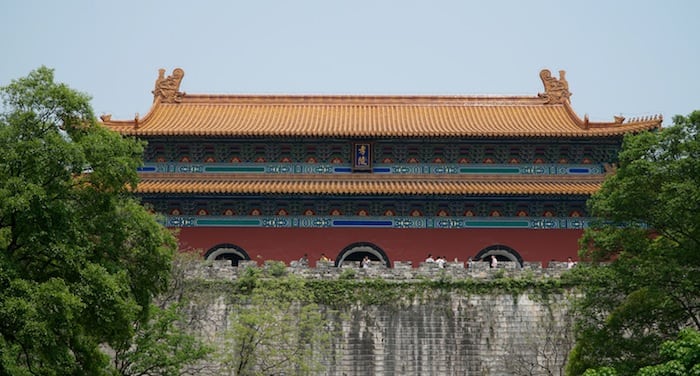 Ming Xiaoling, the main entrance
Ming Xiaoling, the main entrance
Thanks to a three year stay in this city of about eight million inhabitants, and my incurable curiosity on Sunday afternoons, I am ready to share my best recommendations on how to “invest” your time while staying in Nanjing (or Nanchino, in Italian); or, how to also let yourself be seduced by this amazing city.
A fundamental premise: few include this city in their nightly stops, although it’s only about an hour by fast train from Shanghai. Very often, people visit China to see the main sights and skip “secondary” corners, just like this city, among other things defined by the same local classifications as a “secondary city”. There is no other comparison that infuriates the residents of Nanjing more, who are often referred to as the hillbillies of Shanghai.
Look here, this is exactly the wonder of this place, which can let you discover the China that runs and modernizes at the speed of light, together with a cultural and social uniqueness that the bigger metropolises have by now begun to lose.
Nanjing boasts a series of records and is particularly proud that it was the first capital of the Republic and the city chosen by Mr. Sun Yat Sen to found modern China. But even before, in the imperial age, it was well liked by both the Tang and the Ming, that helped it become a marvelous and cutting edge city. Then, sadly, in modern times, it is remembered instead because it was the theater of one of the most bloody and debated civilian massacres, the Rape of Nanjing.
Nanjing is all this; it is, for good or bad, not yet the cosmopolitan metropolis (that it aspires to be!) in the style of Shanghai, despite the recent Youth Olympic Games of 2014 which gave a notable boost to the vitality of this corner of China, capital of Jiangsu.
When to go
Your experience in Nanjing cannot begin without knowing the three fundamental rules: in summer you’ll drop dead from the heat, in winter there are no heaters and in the beginning of the summer and autumn it rains as if Noah is about to sail by.
That said, the moments when Nanjing is at its best are the Spring and late Autumn, between March and April, and October.
How to get there
Besides the Youth Olympics, Nanjing boasts a brand new and super-efficient airport. The just as new S1 metro line directly links to the airport; figure on at least an hour for the trip.
Beyond the long distances, Nanjing is on the high speed line that connects Shanghai and Beijing, therefore it is ably served by the best means of transport in China. Moreover, there are two stations, the old North Station that directly faces Lake Xuanwu (see below) and is connected by Line 1 of the Metro, Nanjing Railway Station stop (南京站), and the newer one, to the south of the city, the Nanjing South Railway Station (南京南站), served by the same Metro and also by Lines 3 and S1.
Where to stay in Nanjing
Click here to read our reviews of the best hotels in Nanjing.
What to see in Nanjing
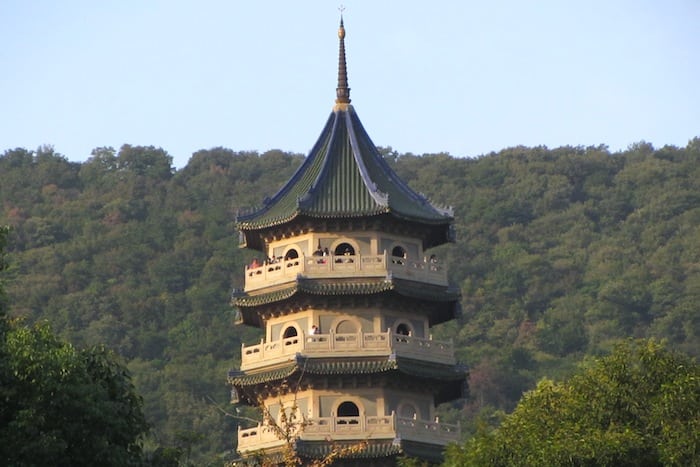 The Linggu Pagoda
The Linggu Pagoda
1. The Purple Mountain (Zijin Shan, 紫金山)
Ok, they call it Purple Mountain, but it’s really little more than a hill. Those who climb it by bicycle might argue the point, since the final stretch is particularly tough. In any case, on this high place there are the remains of the Ming Dynasty that loved the place so much that it is rightly and traditionally held that it was built by the lords enshrined on top. The most attractive part is the Ming Xiaoling (明孝陵景区), a UNESCO protected site, with its path of magnificent statues that have gifted the symbol of the lion to Nanjing.
Even the elephants and the turtles are no joke when it comes to size. Nearby to Ming Xiaoling, it’s worth a visit to theMausoleum of Sun Yat Sen (中山陵园风景区, this is free) which more than anything else has a charm in its size; just like the Linggu Pagoda(灵谷塔), from whose top you can appreciate the skyline of the city.
The park also offers an Observatory, the Nanjing Underwater World – which I strongly do not recommend, unless you want to see a mangy polar bear suffering in the heat -, but above all one of the few swim-able lakes in the city, at least so they say: Lake Zixia (紫霞湖), two steps from the Ming Xiaoling. Sundays and holidays it comes alive with old people who come here to swim free, or families that bring their kids outdoors.
Entrance to Ming Xiaoling is by payment (more than 100 Yuan, but it goes up each year!), same with the lake because it is found inside the district. There is a “loyalty” card that is good for a year but at the price of about three entrances, so I don’t recommend it to temporary travelers.
To reach the park, be ready to walk. The metropolitan line that stops the closest is the 2, Muxuyuan stop (苜蓿园) or Xiamafang (下马坊). There are also numerous buses, such as the 20, the 203 and the 315 that arrive at the gates of the Ming Xiaoling, the 9 and the 5 that arrive at the foot of the mountain. The best is by taxi, in these cases…
2. Lake Xuanwu and the Museum of the Walls
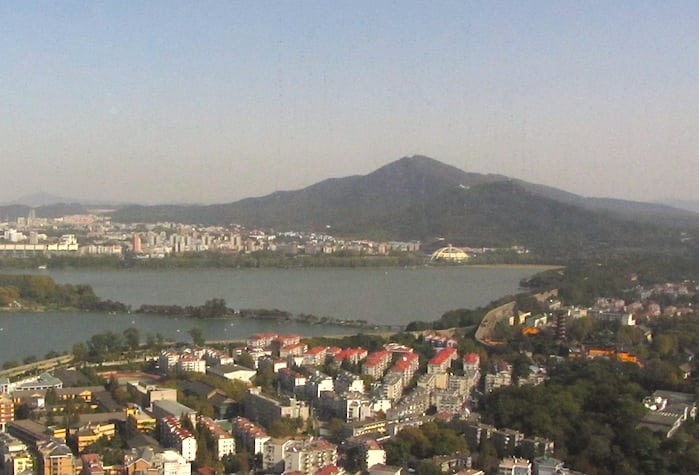 The Purple Mountain and Lake Xuanwu from the highest tower of Nanjing, the Zifeng
The Purple Mountain and Lake Xuanwu from the highest tower of Nanjing, the Zifeng
Right by Ming Xiaoling is one of the most pleasant parks in the city, which ideally signals the northern border from the center of the city. It is the park that surrounds Lake Xuanwu (玄武湖). The lake is artificial, I’ll tell you that right away, but it is the ideal place for a walk (from 9,5 km…) when a little breeze blows or you’re looking for a little tranquility. There are various corners where elderly Chinese station themselves to exercise, both physically and spiritually. The trip though, is not complete without renting one of the little electric boats that allow romantic escapes in the company of him or her…and a selfie stick.
A part of the perimeter of the lake and park is surrounded by the city walls: in particular, from the south entrance, near the temple of Jiming Si (鸡鸣寺), you can visit the Museum of the Walls that offers a glimpse into the history of the construction of the encircling walls, despite the rather meager English captions. From here you can turn on to the perimeter wall and choose to travel a stretch of the “park above”. The Museum of the Walls requires the payment of an entrance ticket for an insignificant fee.
Lake Xuanwu is easily reached by Line 1 of the metro, Xuanwu Men stop (玄武门).
3. Jiming Temple
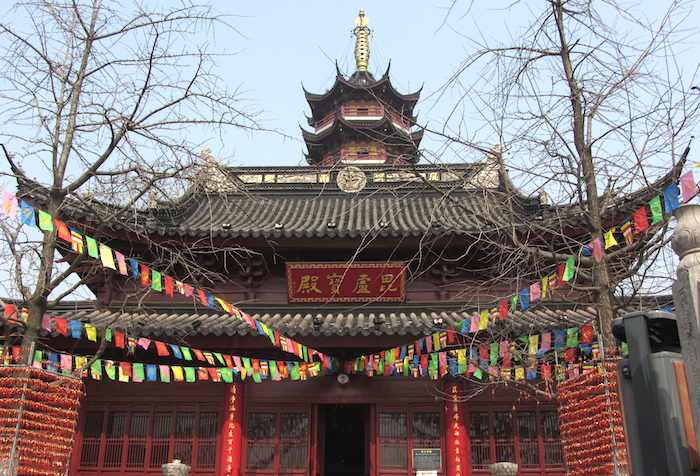 Jiming Temple
Jiming Temple
If instead you prefer to combine a visit to Lake Xuanwu and the Museum of the Walls, then I recommend as a first stop this most famous temple in Nanjing. It’s the Jiming Temple, one of the few remaining in the city to still host a limited number of monks. Be mindful of the stairs, since as is often the case in temples, this too is built on several levels.
This is the best and best kept temple in Nanjing, so if you have only a narrow timetable, I recommend you skip the smaller temples, even if they might be more peaceful or attractive. The temple is easily reached by the stop on Metro 3, recently inaugurated, that bears the same name. Otherwise, walk starting from the Gulou (鼓楼) stop on Line 2 of the metro: a peaceful stroll through the streets of one of the areas still inhabited by the “Nanjing-well-to-do”, or better yet, controlled by the local political class. Refined homes, tree-lined streets and closed-circuit TV cameras distinguish this area from the rest of the city.
If it’s lunch hour, inside Jiming you will find a delicious vegan-vegetarian restaurant of discreet fame, which knows how to be positively considered, however don’t expect the same prices as with street food: Gujiming Temple Vegetarian (古鸡鸣寺素菜馆).
Even the temple entrance requires a fee of 30 Yuan. If you prefer the bus, the 2 and the 3 arrive close to the entrance.
4. The Museum of Nanjing, the Palace and the center of Xinjiekou
Recently restructured, the Museum of Nanjing is a complex of a few buildings all for the purpose of the museum that hosts spacious halls, among which you can lose yourself or suffer a leg-ache. Besides the permanent collection, it also hosts temporary exhibits of traditional Chinese paintings. Some halls are more interesting for penetrating the imperial past and the republican history of the city.
If your legs are still capable of walking after all those kilometers in the museum, I recommend you take the heavily-trafficked and tree-lined main road, Zhong Shan Dong Lu (中山东路), back toward the center, and have a look at the ruins of the Ming Palace (明故宫); quickly, because sadly few ruins are left. From the other side of the street, Wuchaomen Park (午朝门) like all the many parks in Nanjing, hosts gaming and artistic activities once evening falls and early in the morning. On the same street and on both sides, you will find other buildings between the modern and the restored that are worth the walk.
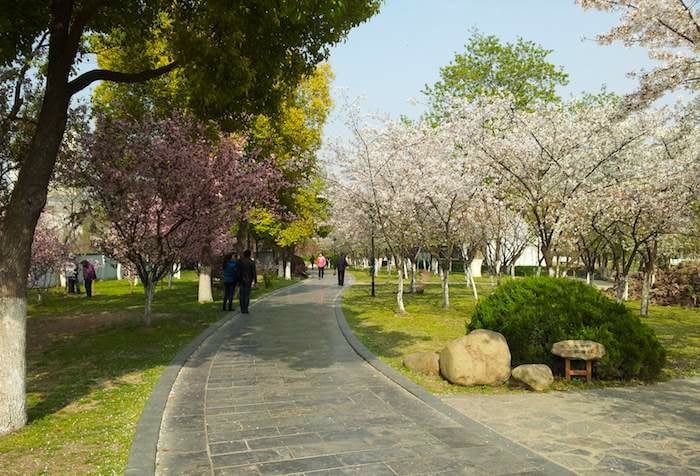 Mochouhu Park
Mochouhu Park
The Museum and the Ming Palace can be reached by metro 2, Minggugong stop (明故宫). From the area of Minggugong to the center, Xinjiekou (新街口), there are only three stops or a half hour walk. Almost all the buses that pass here also go to Xinjiekou. The center, I won’t delude you, has nothing on the “centers” in Italy. It’s rather an enormous hub lined with banks and above all imposing newly-opened commercial centers.
The statue in the center of the principle artery is the founding father of China, Sun Yat-Sen. Even he, subjected to modernity, will seem out of place to you, with arm raised to extol good principles…but sadly turned toward a giant screen which day and night without rest, projects ads for cars, liquor, cigarettes, watches and much else.
5. Zhonghua Gate, Fuzi Temple and the historic quarter
Passing now to the south of the city surrounded by the walls, the lowest point is delineated by the Zhonghua Gate (中华门), one of the best preserved/restored. It is an imposing bastion that guarded Nanjing, once a shelter from the water, and fronted by the Ceramic Pagoda, which has been recently rebuilt but in a modern-futuristic version. So, if you’re going to the top of the watchtower, you’ll notice this building covered in glass lit up at night like a discotheque, don’t be afraid.
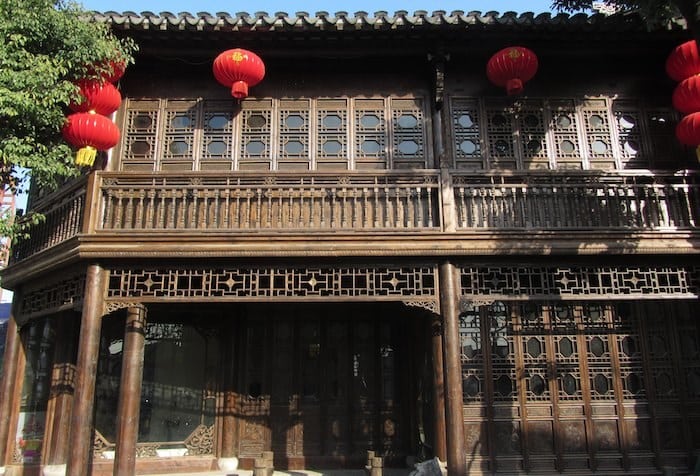 A building of Lao Men Dong
A building of Lao Men Dong
A visit to the Gate (entrance fee) is truly pleasurable: if you’re fortunate (it’s best to go on the weekend or holidays), the city offers a team of volunteers that accompany you, narrating the secrets of Nanjing in English!
Arriving at the top you’ll have two choices: the first is to walk the encircling wall on foot toward the west and admire from above the latest Xiangzi (巷子) remaining, the popular quarters with low houses, thickly clustered, and streets full of commerce and family life. The second alternative is to pay for a ride in a golf-cart and cross the eastern section of the wall, up until past Bailuzhou Park (白鹭洲公园); entrance to the park, as you can understand by now, requires a fee, but the area is really cute, dotted with gazebos in Chinese style full of the elderly singing with an amplifier. The walls pop up right on the little square, home of the bird market, one of the vagaries of the place.
Still another option is to leave the Gate behind and walk the lower wall on foot toward the east in the direction of Laomen Dong (老门东), a popular “old” quarter recently restored in wood, that offers small restaurants serving local dishes, an ancient Chinese atmosphere, original souvenirs and most of all a pleasant walk in the evening air. If the aged maudlin of Laomen Dong hasn’t convinced you, you can try the nearby section of Fuzi Temple (夫子庙), or the Temple of Confucius.
For many years this region has been the only one to reconcile the modern and restored, and to conserve treasures such as the Temple of Confucius, specifically, the History Museum of the Imperial Exams and an attractive glimpse of the Qinhuai River (canal) (秦淮河) from which boat trips leave. Here you’ll find the best restaurants typical of Nanjing, that are just as typically organized..in self-service style. One is as good as another, everywhere you can taste the duck blood soup and the hot tang bao (汤包) – these are the round shaped ravioli, steamed, filled with minced meat and spices, which during its cooking releases its juices into the interior of the ravioli itself; just be careful for the burns!
Moreover, if you don’t know which souvenir to give, this is the empire of little gifts: you’ll find paper cuts, Chinese watercolors on silk (fake and less fake), Yuhua pebbles (雨花石) that are gathered in the region and drive collectors crazy, and much more.
Line 3 of the metro arrives at Fuzimiao, at the stop with its namesake, but also Line 2 stops not far away (Sanshan Jie, 三山街).
6. The Museum of the Massacre and the Chaotian Palace
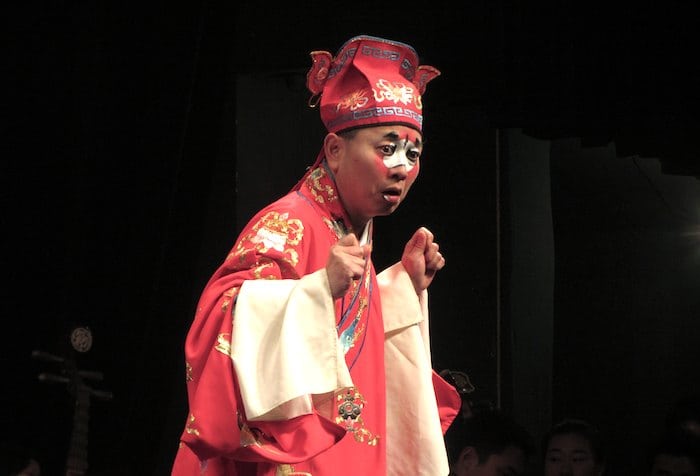 A member of the Kunju Opera
A member of the Kunju Opera
We’ll finish this essential tour on the streets of Nanjing with the west part, just outside the encircling walls. Continuing to the Hanzhong Gate 汉中门 you’ll soon arrive at Chaotian Palace (朝天宫) which very long ago was also the site of a university. The Palace is the site of the Provincial Museum of Nanjing, recently restored and supplied with comments in English: it recounts more fully the story of the city. The space is pleasant and becomes an interesting visit if you combine this with a performance of the Kunju Opera (昆剧), the traditional opera of Jiangsu province.
The entrance to Lan Yuan theater (兰苑剧场) is next to the back door and the performances (afternoon and night, especially on the weekends) are generally apportioned into four different clips, so as not to bore the spectators: if you’re fortunate, you might come across excerpts of funny or acrobatic operas, and automatically the two hours in the theater fly due to the charm of the performance. The most important thing to know is that the performance is subtitled in English on screens!!
A little more to the west is one of the most renowned museums of Nanjing, as well as one of the most important experiences for the history of the city. I can’t tell you that it will be a happy visit, because it’s not. It’s up to you to decide whether to enter the Memorial of the Rape of Nanjing (南京大屠杀纪念馆): between statues of semantic efficiency and beauty, touching photos and interactive products, the viewer goes through the agony of the victims massacred by the Japanese army back in 1937. We’re talking about 300,000 dead, but between rival historical sources and politically motivated historians, there isn’t a number that everyone agrees on.
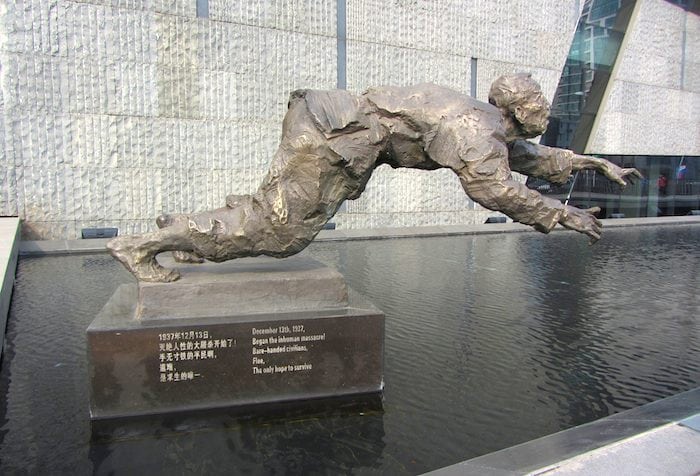 A statue of the Memorial of the Massacre
A statue of the Memorial of the Massacre
If when you come out of the Memorial you’re looking for something a little lighter, right nearby is the Museum of Silk and Brocade (南京云锦博物馆), with live demonstrations of the use of traditional weaving in the composition of the imperial clothing.
Both museums are reachable by Line 2 of the metro, Yunjin Lu stop (云锦路).
7. The parks
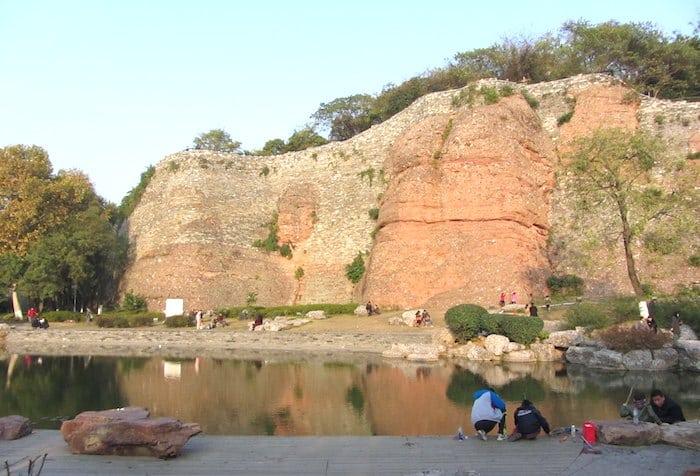 Stone City Ruins Park
Stone City Ruins Park
If you still have time and Nanjing has captivated you, perhaps because you preferred to visit it in the Spring or in Autumn, then all you have left to do is rent a bicycle and head to the parks. Nanjing is dense with parks open to the public until evening (usually 21.00); early in the morning and in the afternoon they are all in turmoil for gymnastics, dance, singing, cards and any other activity you find room for. During the day it’s peaceful and perhaps the best time if you’re looking for a little isolation. I’ve only listed some, feel free to go beyond towards the bigger ones:
- Mochou Hu Park(莫愁湖公园), which circles the second artificial lake of Nanjing;
- Bailuzhou Park (白鹭洲公园), where you can eat dinner on the banks of the Qinhuai River;
- Qingliangshan Park (清凉山公园), where you’ll find vendors of Yuhua pebbles;
- Stone City Ruins Park(头城遗址公园), where it’s possible to appreciate a piece of the original wall;
- Wanjing Park(万景园), where a newly minted biking trail runs alongside the Yangtze and goes up until the Olympic Village.
There are lots more; also the area of Pukou (浦口区) is green and besieged for day trips with adjoining gaming activities and barbecue.
What…to skip
If you’ve read up to this point, then I can tell you what to avoid… look, first of all, the Bridge on the Yangtze ( 南京长江大桥).
Let’s be honest: it’s a monstrosity. Heavily-trafficked, with a lateral path for scooters and pedestrians that is risky and dangerous, the bridge is certainly an imposing work and important for those interested in communist Chinese history. For the average tourist, it is a cement bridge with mastodon-like statues celebrating communism, for which traffic conditions at any hour don’t allow for any movement and are particularly intoxicating. There is an adjacent park, but doesn’t improve the gray industrial appearance. And above all, it is really far from the center.
Just like him, the Presidential Palace (总统府) doesn’t offer anything of particular note. What was once the political center of imperial Nanjing, today it is a bunch of offices. A European tourist will particularly remember that here where the story of China is explained in meticulous summarizing panels, after 1949 there’s nothing. Yes, it all stops. The adjacent garden is cute, but if you want green go to the parks. Next to it, you will find the 1912 quarter, for mundane nights, one that’s all Chinese though!
Finally, it’s up to you whether or not to head south to the Nanjing Eye (南京眼步行桥): an enormous extremely new bridge that was the apple of the Olympic Village’s eye during the Games. Now the neighborhood has lost the charm and vitality of those days, aside from the extremely modern cultural center that is more active than ever. Regardless, a walk on the bridge and surrounding park is a way to imagine how the city was at its most active in the month of August 2014, when it hosted athletes from all over the world.
One last piece of advice: if you’re desperately searching for food of known flavors, take note of these two streets, around which you’ll find various “western style” restaurants: Shanghai Lu (上海路) and Shigu Lu (石鼓路).
If you’ve got up to here, then your next trip to China must include at least a few days in Nanjing!
Photo Credits: Photos by Rita Andreetti



